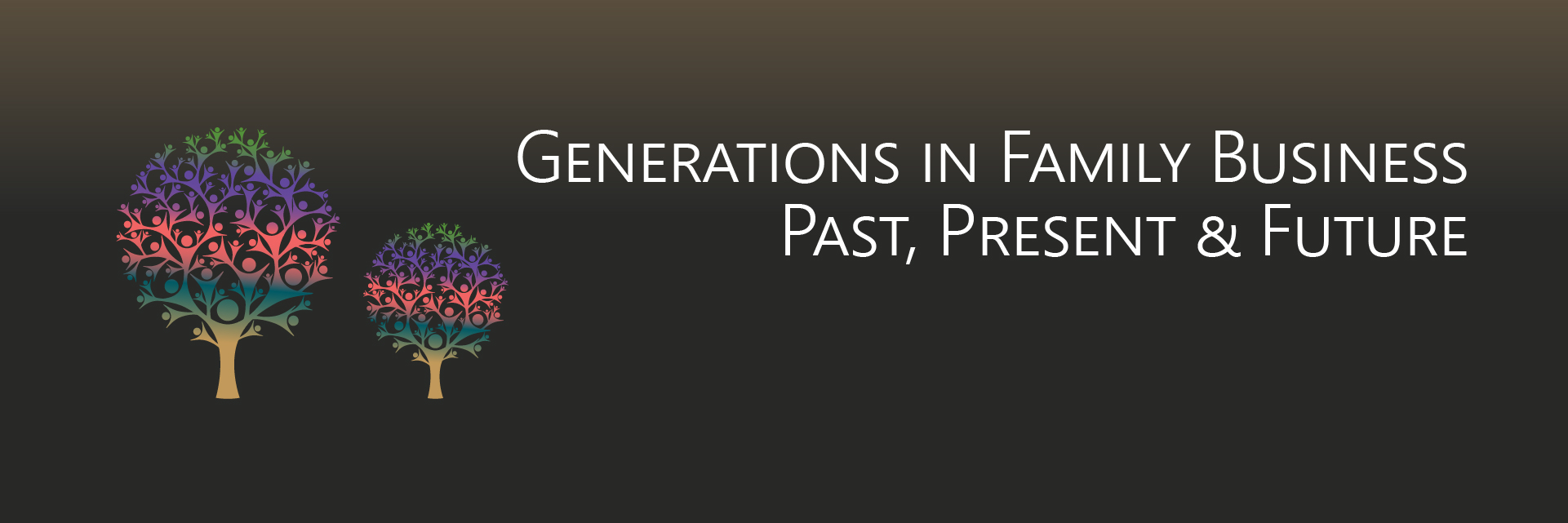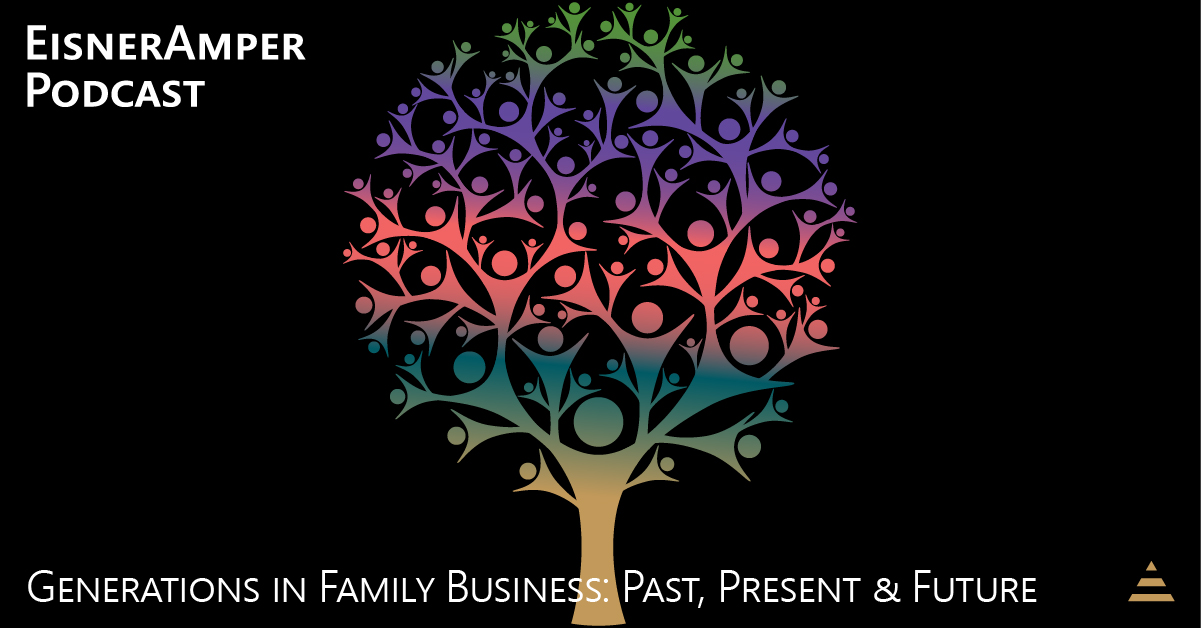
Succession Planning Process: Roadmap to Successful Succession
- Published
- Oct 16, 2019
- Share
Matt Kerzner and Tim Schuster discuss the six steps the Center for Family Business Excellence takes a client through regarding succession planning.
Transcript
Tim Schuster: Welcome to our podcast for “Generations in Family Business: Past, Present, and Future.” Our host for this podcast are myself, Tim Schuster, a senior manager in EisnerAmper’s Center for Family Business Excellence. And along with us, as always, is …
Matt Kerzner: … Matt Kerzner, and I'm the director at the Center for Family Business Excellence.
TS: Matt, always good to see you. So I'm excited about this series of podcasts that we're doing. It's going to revolve around succession planning. This is an area that you and I have had a lot of discussions about—a very hot topic with a lot of our clients. Actually, you wanted to share some statistics with our audience members, so please feel free to share.
MK: Yes, thank you. I do want to talk a little bit about some major trends that are happening in family businesses or tightly held businesses. First, people think that family businesses last for generations, but the estimated time and life span of a family owned business is really one generation, about 24 years. That's a really important stat to understand. 40% of family business owners expect to retire within the next decade. So I like to say we're in this tsunami where all the Baby Boomers are looking to retire.
And another one is this is money. There's going to be $10.4 trillion in family wealth that will be transferred over the next decade or two.
TS: A trillion with a t?
MK: Yes. Here’s another interesting stat. 35% of Fortune 500 businesses are family owned. So people think that family business are small mom and pop shops, but they're actually large organizations. According to the U.S. Small Business Administration, 90% of all businesses in the U.S. are family owned or jointly owned and equally operated by husband and wife. That's another really cool stat. There are some challenges of the family-owned businesses. Owners of the company wear a couple of different hats. They're not just the owners, but they're also fathers, mothers, right? They have these different hats that they wear that can get really blurred, and that could cause some issues. Another one that I just want to talk a little bit about is what's called this resistance to succession planning because there's some psychological issues that are going on with the owners of the business.
Studies show that there's something that happened when they were young within their family that really drove them to be an entrepreneur, to want to own a family business or run a family business. When you start talking about succession or even exits, to transitioning or selling the business, it's very emotional to the person who started the business because of that bond. That business actually is a sibling or a child, so it's very challenging for them. There's some of this resistance when we get into this whole succession planning series. I'm going to get into the emotional issues that could be resistance for owners selling or not selling. It could be selling or transitioning it to the next generation.
TS: The emotional side of this whole process really is a big factor. Yeah, the money's a big thing, but the emotion that goes into it is truly fascinating. And as Matt alluded to, there is a six-step process that we follow at the Center for Family Business Excellence. Throughout the course of the series, we're going to be discussing this a little bit more in depth. We just want to give everyone here a flavor as to what to expect over the next coming months. So, Matt, let's talk about the first step in the process: transition and exit strategy.
MK: Before we jump into each one, Tim, let me just give you each step so people can understand. So there is a six-step process as you just mentioned, and that's our proven methodology at the Center. Step one is transition exit strategy. Step two is governance. Step three is the growth and value enhancement, you really have to understand the value of the business. Then there's what's called execution and accountability. How do you hold yourself and your family members accountable as well as your senior leaders? Then you have to take a look at your leadership development, your bench strength, because you might have family members who are not ready. You have to look at your non-family members or you might have to go outside. So you have to look at leadership development. Then, after that, the final step is the succession, the actual execution of transitioning to the next generation or a non-family member and bringing it all together.
TS: So we'll start with the first one, Matt—transition and exit strategy.
MK: At a very high level, you want to make sure that there's what's called financial readiness. Are you ready? What are your financial expectations from the business? You'll be surprised, most family owned business owners only have about $40,000 for retirement. Think about that. I mean, small, medium-sized businesses, because most of their money is invested in the business. The real estate, capital, inventory, and so forth. People are shocked when they a want to retire and they don't have the means to do that. You want to make sure that there's this financial readiness regarding what the business needs to do? Enable you and your family to realize your vision of the transition or exit. It's really important. The transition planning, thinking it through, is very critical as well as putting a plan together. That’s number one.
TS: Now number two. Let's talk about governance.
MK: The second one is governance and family business systems. There are three major buckets that we look at in the Center. Not in this order, but the family, the business and the ownership, and you examine the triangle trifecta. You want to see how that all works together, but when you're putting your governance and your family systems together, you want to make sure that you're aligning the business and family interest that we just talked about. You want to look at estate planning. Do you have your estate in order? Do you have enough to retire? Any agreements right now that you're transitioning the business over? How are you going to do buyouts or operating agreements and how is the next generation understanding that?
Another one is when owners are looking to transition. They still want to be involved, so we actually can help develop family councils to help the family stay involved with the business, especially if there's going to be a non-family CEO sitting at the helm. Putting together advisory boards, which we get into more in depth at a later podcast. Do you have policies and procedures regarding the family guidance, how they come into the business, how involved they are, the dos and don'ts of involvement, and understanding roles and responsibilities? These are governance and family systems.
TS: That's fantastic. Let's go to step three now. How about growth and value enhancements?
MK: That is what does the business need to look like in five to 10 years? It’s putting that strategic plan together and making sure you understand current state and where you want to take this business. Future state. So that's really, and we'll get more into that after, but it's really looking at how are you growing the business and building your bench strength.
TS: Let's talk about step four now, execution and accountability.
MK: This one is building a culture of accountability and how you review and measure yourself. Manage the performance, review the progress, and remove all barriers about the business. It's really how you are going to hold your family accountable through this process.
TS: Makes sense. Step five, leadership development.
MK: I love this one. My background is HR organization. Leadership development is looking at your bench strength, not just your family, but your senior leaders, even your board members. If you have a board, looking at what strengths they have and what areas of opportunities they need to develop. If you are the owner of a business and you're now transitioning it to the next generation or non-family member, you want to make sure that all of the players, the bench, have the skills to keep the business going. I always say when a CEO or an owner is now going to retire, move on, or transition the business, how many hats do they actually wear? We’ve talked about this in the past. They do five jobs. It's not like they work 40 hours a week. They do 80 or 100 hours per week. Does your bench have the skill sets, and how many people does it take to replace you if you're retiring or moving on? That's leadership development.
I have a formula that we talked about in the past. Leadership + training + tools = success. That's what I mean by leadership development. Then when you're doing that, you look at what's called the individual leadership development plans, and we can help develop those plans to get the people the skills, knowledge, and ability to be ready.
TS: I like it. Finally, number six. It's the session itself.
MK: So we already talked a little bit about building the bench strength. The succession planning, I can't stress this enough, Tim. You’ve got to start early.
TS: Almost right away actually.
MK: Yes. If you're thinking of transitioning in five years, start the process now. Identify who you have as your possible successor, and we can provide some assessments to figure out where they are currently and what they need to do to develop themselves to become ready. When we're putting that plan together, and we're five years out looking at who you have in the family, who you have in senior leadership and then we look at some processes like job descriptions, job analysis, how many roles and hats you wear as an owner. Do we need to replace those or do we just develop who you have?
TS: How do we link all this back to the strategic roadmap?
MK: For those who haven't heard the other podcasts that we did, we have a whole series on this strategic roadmap. They’re about developing that three-to-five year plan and what the mission, vision and values are. How do you grow the business, how do you do operation efficiency and how you do people development? Again, succession planning actually covers all three. How do you maintain the business? How do you keep it growing? How do you look at operation efficiency? You might have to get out of that entrepreneurial mindset and really put some structures together because you're not going to run the business in the future. So you want to have some systems in place. And then the last one, which I think is the most important one, is really developing your people to be ready, because if you're the owner and you've been there for 24 years, you've got a little bit of resistance. You want to feel comfortable that your folks, your family members, are capable of running the business.
And then the last thing I want to just talk about is I always encourage when you're transitioning this business to family or even non-family members, make sure that you're building a solid team. Who is your good family business advisor? Is it your personal financial planner or wealth management advisor? Make sure that you have enough money to live on for the life that you want. Make sure you have a solid attorney on your staff who can do estate planning tax law to make sure you understand that. Have a business and legal attorney to make sure that you're crossing your Is and dotting your Ts. You want to make sure you have the right insurance folks on your team. These are business, personal, estate planning. Make sure that you are safe and protected. You've got to have a CPA, right? You've got to have tax management and understand the tax implications of this process. Everything that you do has tax implications! And then I always say make sure you have a really solid business valuation resource, somebody who can help you understand what the value of the business is, because there's always that fork in the road. If you're not comfortable transitioning this business to a non-family member, then understand what the value of your businesses is, in case you need to look for alternative.
TS: That makes sense to me. Thank you so much for that useful information Matt. And thank you for listening to “Generations in Family Business: Past, Present, and Future” as part of the EisnerAmper podcast series. If you have any questions or there's a topic you'd like us to cover, email us at contact@eisneramper.com. Visit eisneramper.com for more information on this and a host of other topics. We look forward to have you listening and our next EisnerAmper podcast.
Also Available On
More in this Series

Succession Planning Process: Transition & Exit Strategy

Succession Planning Process: Governance

Succession Planning Process: Growth and Values

Succession Planning Process: Execution & Accountability

Succession Planning Process: Leadership & Development
What's on Your Mind?
Start a conversation with Timothy
Receive the latest business insights, analysis, and perspectives from EisnerAmper professionals.












